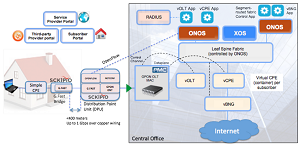News
New-Age Networking Project Transforms Carrier Central Offices
At the recent Open Networking Summit, a project demonstrated the implementation of next-generation networking technologies in telecom carriers' central offices, re-architecting the infrastructure by using open standards software and commodity hardware to replace proprietary, fragmented systems.
The Central Office Re-architected as Datacenter (CORD) proof-of-concept (POC), was led by ON.Lab and its Open Networking Operating System (ONOS) project. AT&T acted as the service provider and PMC-Sierra and Sckipio provided merchant silicon hardware components.
The concept being proved involved telecom and cable carriers leveraging new-age software-defined networking (SDN) and network functions virtualization (NFV) technologies to turn their carrier functionality into hosted workloads running on white-box, or commodity, hardware. The participants said this approach effectively provides Infrastructure-as-a-Service (IaaS) and networking services as applications that run on the commodity hardware, capitalizing on the agility and scale provided by cloud computing.
"CORD enables service providers to build an underlying common infrastructure with white boxes using ONOS (carrier-grade open source SDN control plane), OpenStack (virtual infrastructure management) and XOS (an open source service orchestration/management platform built on OpenStack) with a diversity of organizations building the services and solutions that ride above," ON.Lab said in a news release. "In effect, this common infrastructure replaces the fragmented, non-commodity one in today's central offices where each site hosts more than 300 unique deployed appliances, each requiring a physical install and specialized management."
 [Click on image for larger view.] The Cord Setup (source: ON.Lab ONOS Project).
[Click on image for larger view.] The Cord Setup (source: ON.Lab ONOS Project).
The CORD project aims to highlight the benefits of the approach to three types of end users -- service providers, subscribers and third-party providers -- listing the key capabilities for each.
For service providers, key capabilities include:
- SDN control, orchestration and management with ONOS, OpenStack and XOS on commodity infrastructure.
- An open high-performance leaf-spine fabric.
- OpenFlow-enabled PON OLT MAC hardware enabling virtualization of the traditional Optical Line Termination (OLT).
- OpenFlow-enabled G.fast distribution point unit (DPU).
- Access-as-Service, Subscriber-as-a-Service, Internet-as-a-Service, Caching/Content Delivery-as-a-Service, virtualized functions including firewall, URL filtering, parental control and Broadband Network Gateway (BNG).
- Service provider portal for intuitive provisioning, management and monitoring of infrastructure and services.
For subscribers, they are:
- Simple customer premises equipment (CPE) that replaces existing complex CPEs and can be managed by ONOS.
- Internet, firewall, parental control services.
- Subscriber portal for signing up for and managing services.
For third-party providers, they are:
- Content delivery (caching) for their own content in the service provider network.
- Third-party provider portal for signing up for and managing services.
"SDN and NFV are speeding up innovation, as seen in projects like CORD," said AT&T exec Tom Anschutz. "These technologies create systems that do not need new standards to function and enable new behaviors in software, which decreases development time. Faster development time leads to rapid innovation, something the industry needs to continue satisfying data-hungry customers."
After the demo at the Open Networking Summit, the CORD project was scheduled to continue development efforts and proceed to lab trials, with a CORD bundle of software and hardware expected to be made available in a ready-to-use "Pod" to service providers for testing by the end of this year.
ON.Lab also said the software used in the CORD demo will be available to the general public as part of the next ONOS release -- called Drake -- in late August. ONOS version 1.2, called Cardinal, was unveiled earlier this month as part of the ONOS three-month release cadence.
About the Author
David Ramel is an editor and writer at Converge 360.